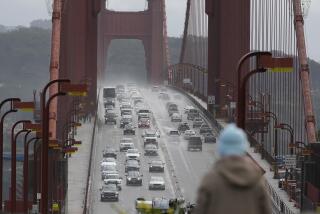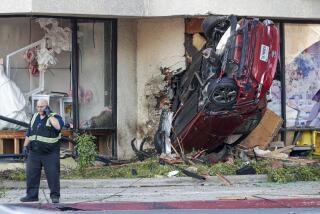DUI’s new enemy: robocars
Skynet has not become self-aware, but it’s hard to escape the feeling that we’re heading for a “Terminator”-like future in which intelligent machines start wanting to run the show, what with cellphones that can talk to us and websites that can peg our entertainment preferences with eerie accuracy. So it should come as little surprise that someday our cars might exercise better judgment than we do.
A new electronic device may be on the horizon that goes well beyond such common automotive safety features as alarms that nag us to buckle our seat belts or daytime running lights that won’t let us turn them off: sensors that can smell a driver’s breath and block ignition if they determine that he or she is drunk.
The Senate version of the federal transportation bill calls for $24 million in additional funding over two years — on top of the $10 million over five years already devoted to the program — for research on alcohol-sensing technology in vehicles. The idea is to find out whether it would be feasible to demand that automakers include this technology as standard equipment in future cars. That’s a big departure from the way so-called interlock devices currently work.
Some states require people convicted of drunk driving to have interlocks installed in their vehicles; they have to breathe into a tube, and if the device senses that their blood-alcohol level is over the legal limit (0.08% nationwide), their cars won’t start. California’s four largest counties, including Los Angeles, currently impose this penalty. But that applies only to known drunk drivers: The federal program might someday apply to everybody.
This does not please the restaurant industry. The American Beverage Institute, a restaurant trade association, objects that the devices will be set to detect alcohol at well below the legal limit, meaning a motorist who downs a glass or two of wine at a local eatery might have to call a cab to get home. Moreover, it says the devices will sometimes fail, blocking ignition even for sober people. Those are legitimate points, and if the predictions are borne out, they might be reason enough to urge future leaders not to approve universal interlocks. But that shouldn’t stop the government from researching the idea.
One point of the federal program is to find a technology that is unobtrusive. The two most promising technologies under study are tissue spectrometry, which would use a touchpad and lasers to detect alcohol in human tissue, and distant spectrometry, in which sensors installed throughout the cabin could sniff a driver’s breath automatically (apparently, the sensors can be placed in such as way as to ensure it’s the driver’s breath they’re sniffing, not passengers’).
The restaurant association seems to be correct that the devices would be programmed to detect alcohol at below the legal limit. Sarah Ferguson, a leader of the joint venture of the Automotive Coalition for Traffic Safety and the National Highway Traffic Safety Administration that is directing research on the concept, concedes this point. In 2009, she told a columnist with the Milwaukee Journal Sentinel that the devices would be set with a safety margin because it’s better to “erroneously stop an innocent than to erroneously permit a drunk.” The Beverage Institute also complains that, under accepted failure-analysis modeling, the devices would be reliable only 99.99966% of the time, which means that roughly 4,000 drivers in the U.S. per day would experience an ignition malfunction.
There are other reasons to object. The devices would detect only alcohol use, meaning one could still smoke pot, drop acid or snort cocaine and get behind the wheel. That one’s pretty easy to dismiss: Drunk drivers kill roughly five times more people than drivers impaired by other drugs. Meanwhile, statistics show that the incidence of drunk driving is declining, so why take this step now? Also easy to dismiss: Because drunk drivers are implicated in nearly one-third of traffic deaths in the United States, killing roughly 11,000 people a year.
Conservatives see the interlock research as liberal interventionism, imposing extra costs on consumers to protect them from themselves. But that’s pretty much the way they felt about Ralph Nader’s pioneering investigations into automotive safety in the mid-1960s, which led to such standard features as seat belts — and that worked out OK. If sensors can thwart drunk drivers, they could save thousands of lives. And if research shows that they fail at an unacceptable rate, or catch drivers who aren’t legally drunk, they’re unlikely to attract the political support needed for approval.
The restaurant industry would like to quash the program before these questions are answered. We’d rather wait until the data are in to decide whether or not to accept the interlock concept.
More to Read
A cure for the common opinion
Get thought-provoking perspectives with our weekly newsletter.
You may occasionally receive promotional content from the Los Angeles Times.










